mobile View, to the German Version tap the flag
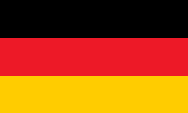

- Islamic Emirate of Afghanistan
- own name: Da Afghanistan Islami Amarat
• Flag
• Historical Flags
• Meaning/Origin of the Flag
• Local Flags
• Coat of Arms
• Meaning/Origin of the Coat of Arms
• Aircraft Roundel
• Map
• Numbers and Facts
• History
• Origin of the Country's Name
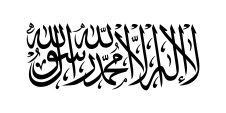
since 15.Aug.2021,
National flag,
ratio = 1:2,
Source: Own work based on: the flag raised at a 17 August 2021 Taliban press conference,
Public domain, via Wikimedia Commons





1880–1901,
Emirate of Afghanistan,
National flag,
ratio = 3:5,
Source, by: Wikipedia (D)



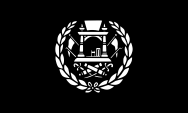
1901–1919,
Emirate of Afghanistan,
National flag,
ratio = 3:5,
Source, by: www.afghan-network.net,
Wikipedia (D), QWerk. [CC BY-SA 3.0], via Wikimedia Commons



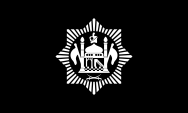
1919–1921,
Emirate of Afghanistan,
National flag,
ratio = 3:5,
Source, by: www.afghan-network.net,
Wikipedia (D), Flanker. [Public domain], via Wikimedia Commons



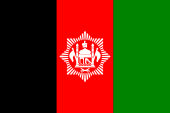
1929–1931,
Kingdom of Afghanistan,
National flag,
ratio = 2:3,
Source, by: www.afghan-network.net,
Wikipedia (D)



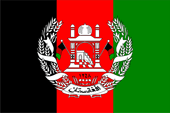
1931–1974,
Kingdom of Afghanistan,
National flag,
ratio = 2:3,
Source, by: www.afghan-network.net,
Derivative work by Orange Tuesday at en.wikipedia based on OpenClipart file is by Andrew Dunhan [Public domain], via Wikimedia Commons



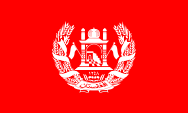
1928–1973,
Flag of the Shah (front),
ratio = 3:5,
Source, by: Das Flaggenbuch



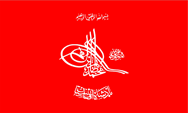
1928–1973,
Flag of the Shah (reverse),
ratio = 3:5,
Source, by: Das Flaggenbuch



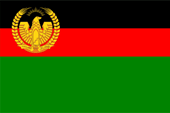
1974–1978,
Republic of Afghanistan,
National flag,
ratio = 2:3,
Source, by: www.afghan-network.net,
Wikipedia (D), Orange Tuesday (talk) at en.wikipedia. [Public domain], from Wikimedia Commons



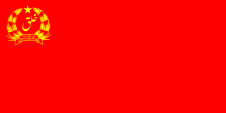
1978–1980,
Democratic Republic of Afghanistan,
National flag,
ratio = 1:2,
Source, by: www.afghan-network.net,
Wikipedia (D), Orange Tuesday [Public domain], via Wikimedia Commons



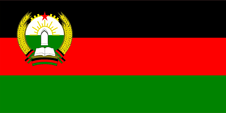
1980–1987,
Democratic Republic of Afghanistan,
National flag,
ratio = 1:2,
Source, by: www.afghan-network.net,
Corel Draw 4, Wikipedia (D)



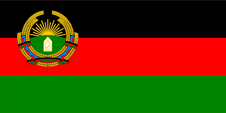
1987–1992,
Democratic Republic of Afghanistan,
National flag,
ratio = 1:2,
Source, by: www.afghan-network.net,
Wikipedia (D), Orange Tuesday. [Public domain], from Wikimedia Commons



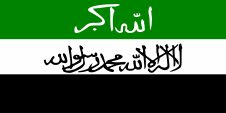
1992,
National flag,
ratio = 1:2,
Source, by: www.afghan-network.net



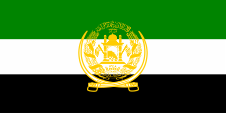
1992–2002,
Islamic State of Afghanistan, National flag,
Flag of the Northern Alliance,
ratio = 1:2,
Source, by: Flags of all Nations, User:Saul ip [GFDL or CC BY-SA 4.0], via Wikimedia Commons



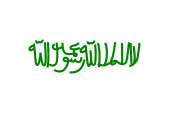
1996–2001,
Islamic Emirate of Afghanistan, National flag,
Flag of Taliban Militia,
ratio = 2:3,
Source, by: Frank Grübe



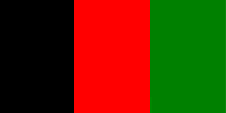
28.Jan.2002 – 05.Feb.2002,
Republic of Afghanistan,
National flag,
ratio = 1:2



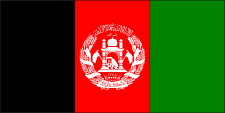
05.Feb.2002 – 04.Jan.2004,
Republic of Afghanistan,
National flag,
ratio = 1:2,
Source, by: National flagn der Welt, Antemister, arms created by Dbenbenn [CC BY 3.0], via Wikimedia Commons



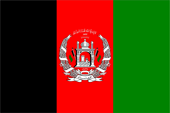
04.Jan.2004–19.Aug.2013,
Republic of Afghanistan,
National flag,
ratio = 2:3,
Source, by: Wikipedia (D), Bahij Virtual Academy [CC BY-SA 4.0], from Wikimedia Commons





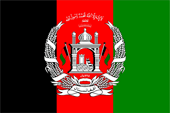
19.Aug.2013–15.Aug.2021,
National flag,
ratio = 2:3,
Source, by:
Wikipedia (D), Bahij Virtual Academy [CC BY-SA 4.0], from Wikimedia Commons




The today's flag of Afghanistan was introduced on 15th of August in 2021 after the Taliban militia regained power in Afghanistan. It is solid white and shows the Shahada, the Islamic creed, in black Arabic script. It leans consciously on the flag of Saudi Arabia, because the ideology of the Taliban goes back to Wahabi Islam in Saudi Arabia. The to 15th of August in 2021 used flag of Afghanistan was introduced on 19th of August in 2013 and showed three vertical stripes, black, red and green, with the coat of arms of the state in the centre. The flag correlated nearly with the model which was valid until 1974 in the Kingdom of Afghanistan. At the top of the coat of arms only the chessada (Islamic creed) was added.
Meaning of the former colors: black stands for the dark past, red symbolizes the in the fights for freedom given blood, and green stands for the Islam. Just as is possible a pure islamic interpretation of the colors: Red is the colour of Omar, the second calif; green stands for the Fatimides, an Ismailitic-shiite calif-dynasty, which goes back to the fourth Calif Ali; and black stands for the Abbasides, a calif-dynasty, which goes back to the Calif Abbas I. Already during the times of the kingdom, 1929-1974, the black-red-green stripes of the flag had been arranged vertically. With the assumption of power by Mohammed Daud Khan, and on the occasion of the formation of the presidial republic they were arranged horizontally. After a communist coup, lead by M. N. Taraki, a red single coloured communist flag was introduced between 1978 and 1980,. After an uprising and internal struggles for the power, B. Karmal took control, Soviet troops marched in, and a horizontally striped flagt was introduced, which contained a coat of arms with the historical elements, completed by a red star and an opened Koran. With the change of regime from B. Karmal to Dr. M. Najibullah in 1987 the coat of arms was also changed. The star and the Koran were removed. After the takeover by the Mudjaheddin in 1992, they decided on new national colours, namely green, white and black. The colour white stood for the future. In the religious-Islamic sense white stands for the Omajiades, a calif-dynasty, which goes back to the fifth calif, Moawija 1st.
Source:
Flags of the World,
Wikipedia (D),
World Statesmen,
Die Welt der Flaggen,
Flaggen Wappen Hymnen
Translator of the English text: Joachim Nuthack

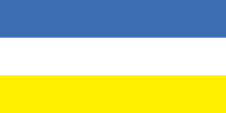
Flag of the Hazarajat,
ratio = 1:2,
Source, by: Wikipedia (EN)



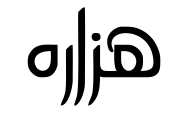
Flag of the Hazara (Hazaras),
Quelle, nach: Wikipedia (EN)




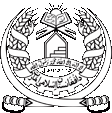
since 15.Aug.2021,
Coat of arms of Afghanistan,
Source: Falerístico, CC BY-SA 4.0, via Wikimedia Commons
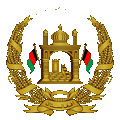
2004–2021,
Coat of arms of Afghanistan,
Source, by:
Bahij Virtual Academy [CC BY-SA 4.0], from Wikimedia Commons

The today's coat of arms of Afghanistan was introduced on 15th of August in 2021 after the Taliban militia regained power in Afghanistan. It shows in the colors black and white a wreath of ears between two crossed swords and in the middle a rising sun, an open Koran, a sermon pulpit, the name of the state, the year the state was founded and the Shahada, the Islamic creed, all in Arabic script. The to 15th of August in 2021 used coat of arms of Afghanistan showed, also before and for many years, an open mosque with prayer-niche and sermon pulpit, and on the outside of each side of the mosque stands, obliquely placed, a flag. The mosque was encircled by a bound wreath of grain ears, and since 1996, by the Shakhada as well.
Source: National flagn der Welt, Volker Preuß

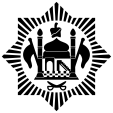
1924-1928,
Aircraft Roundel,
Source, by: Wikipedia (EN)
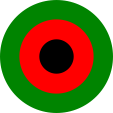
1929–1965,
Aircraft Roundel,
Source, by: Wikipedia (EN)
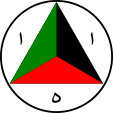
1965-1978,
Aircraft Roundel,
Source, by: Wikipedia (EN)
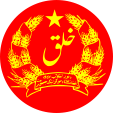
1979–1983,
Aircraft Roundel,
Source, by: Wikipedia (EN)

1983–1992,
Aircraft Roundel,
Source, by: Wikipedia (EN)
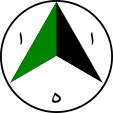
1992-2002,
Aircraft Roundel,
Source, by: Wikipedia (EN)
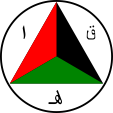
2002–2021,
Aircraft Roundel,
Source, by: Wikipedia (EN)

Location:
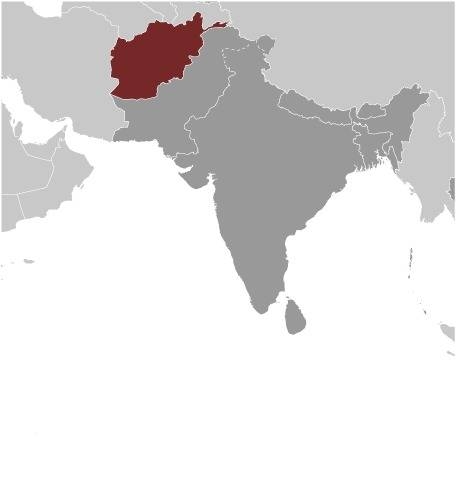
Source: CIA World Factbook
Map of the country:
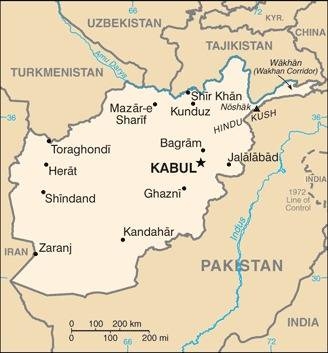
Source: CIA World Factbook

Area: 252.071 square miles
Inhabitants: 34.941.000 (2018), thereof 40% Pashtuns, 27% Tadjiks, 9% Uzbeks, 9% Hazara
Religions: 99% Muslim (80% Sunni, 20% Shia)
Density of Population: 139 inh./sq.mi.
Capital: Kabul, 4.273.150 inh. (2020)
official Language: Pashtu, Dari (New Persian)
other Languages: Tadjik, Uzbek
Currency: 1 Afghani (Af, AFN) = 100 Puls
Time Zone: GMT + 4,5 h
Source:
Wikipedia (D),
World Statesmen

500/600 B.C. · Baktrian Empire
630 B.C. · Persian conquest
330 B.C. · Greek conquest
323 B.C. · to the empire of the Seleucides
3rd cent. · to the Persian empire of Sassanides
664 · Arabian conquest
977–1186 · empire of Ghaznavides
13th/14th cent. · Mongol invasion
16th cent. · to the Persian Empire of the Safavides
1747 · establishment of Afghanistan
1838–1842 · war against Great Britain
1878–1880 · war against Great Britain
1907 · British half-colony
9th of August 1919 · independence
1973 · fall of the monarchy
1979–1989 · occupied by troops of the Soviet Union
2001 · onset of the US-american occupation
2021 · end of the US-american occupation, seizure of power by the Taliban militia
Source:
Atlas zur Geschichte,
Wikipedia (D),
World Statesmen

"Afghanistan" literally means "Land of the Afghans". "Afghans" is the historical Persian name for the people of the Pashtuns, first mentioned in 1801, officially introduced in 1919. The Pashtuns with 60% are the majority within the population.
Source: Wikipedia (D)


![]()












































































